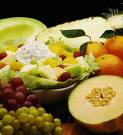
Fruit Salad


|
Fruit Salad |

|
|
Fruit Salad Home
Hedge Apple Mango Kiwi Guava Cherimoya Jackfruit Guarana Kumquat Aubergine |
Hedge Apple
|
The Osage-orange (Maclura pomifera) is a plant in the mulberry family Moraceae. It is also known as Osage-apple, mock orange, hedge-apple, horse-apple, hedge ball, bois d'arc, bodark (mainly in Oklahoma and Texas), and bow wood. Common slang terms for it include monkey brain, monkey ball, monkey orange, and brain fruit due to its brainlike appearance. The species is dioeceous, with male and female flowers on different plants. It is a small deciduous tree or large shrub, typically growing to 8-15 m tall. The fruit, a syncarp of achenes, is roughly spherical, but bumpy, and 7-15 cm in diameter, and it is filled with a sticky white latex sap. In fall, its color turns a bright yellow-green and it has a faint odor similar to that of oranges. Maclura pomifera is the sole surviving member of the genus Maclura—of its many relatives from past geologic eras, only fossils remain. It is also, however, a member of the family Moraceae, which encompasses the mulberries and the figs, as well as a large number of tropical and semitropical trees. The fruits have a pleasant and mild odor, but are inedible for the most part. Although not strongly poisonous, eating it may cause vomiting. The fruits are sometimes torn apart by squirrels to get at the seeds, but few other native animals make use of it as a food source. This is unusual, as most large fleshy fruits serve the function of seed dispersal, accomplished by their consumption by large animals. One recent hypothesis is that the Osage-orange fruit was eaten by a giant ground sloth that became extinct shortly after the first human settlement of North America. Other extinct Pleistocene megafauna, like the mammoth, mastodon and gomphothere may have fed on the fruit and aided in seed dispersal. An equine species that went extinct at the same time also has been suggested as the plant's original dispersal mechanism because modern horses and other livestock will sometimes eat the fruit. |